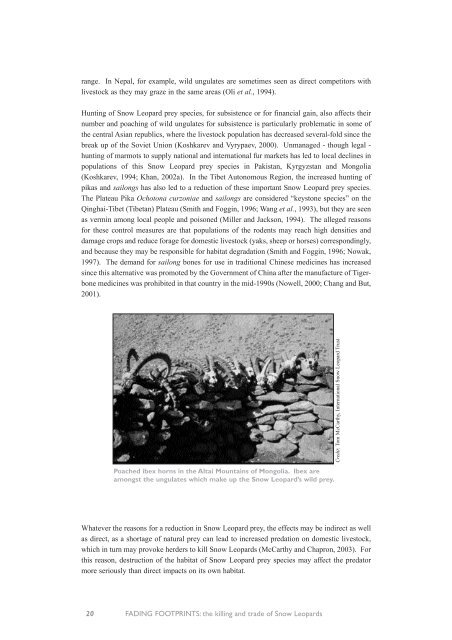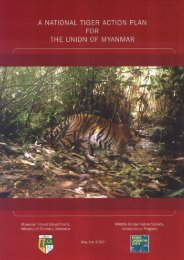Download - Global Tiger Initiative
Download - Global Tiger Initiative
Download - Global Tiger Initiative
Create successful ePaper yourself
Turn your PDF publications into a flip-book with our unique Google optimized e-Paper software.
ange. In Nepal, for example, wild ungulates are sometimes seen as direct competitors with<br />
livestock as they may graze in the same areas (Oli et al., 1994).<br />
Hunting of Snow Leopard prey species, for subsistence or for financial gain, also affects their<br />
number and poaching of wild ungulates for subsistence is particularly problematic in some of<br />
the central Asian republics, where the livestock population has decreased several-fold since the<br />
break up of the Soviet Union (Koshkarev and Vyrypaev, 2000). Unmanaged - though legal -<br />
hunting of marmots to supply national and international fur markets has led to local declines in<br />
populations of this Snow Leopard prey species in Pakistan, Kyrgyzstan and Mongolia<br />
(Koshkarev, 1994; Khan, 2002a). In the Tibet Autonomous Region, the increased hunting of<br />
pikas and sailongs has also led to a reduction of these important Snow Leopard prey species.<br />
The Plateau Pika Ochotona curzoniae and sailongs are considered “keystone species” on the<br />
Qinghai-Tibet (Tibetan) Plateau (Smith and Foggin, 1996; Wang et al., 1993), but they are seen<br />
as vermin among local people and poisoned (Miller and Jackson, 1994). The alleged reasons<br />
for these control measures are that populations of the rodents may reach high densities and<br />
damage crops and reduce forage for domestic livestock (yaks, sheep or horses) correspondingly,<br />
and because they may be responsible for habitat degradation (Smith and Foggin, 1996; Nowak,<br />
1997). The demand for sailong bones for use in traditional Chinese medicines has increased<br />
since this alternative was promoted by the Government of China after the manufacture of <strong>Tiger</strong>bone<br />
medicines was prohibited in that country in the mid-1990s (Nowell, 2000; Chang and But,<br />
2001).<br />
Credit: Tom McCarthy, International Snow Leopard Trust<br />
Poached ibex horns in the Altai Mountains of Mongolia. Ibex are<br />
amongst the ungulates which make up the Snow Leopard’s wild prey.<br />
Whatever the reasons for a reduction in Snow Leopard prey, the effects may be indirect as well<br />
as direct, as a shortage of natural prey can lead to increased predation on domestic livestock,<br />
which in turn may provoke herders to kill Snow Leopards (McCarthy and Chapron, 2003). For<br />
this reason, destruction of the habitat of Snow Leopard prey species may affect the predator<br />
more seriously than direct impacts on its own habitat.<br />
20 FADING FOOTPRINTS: the killing and trade of Snow Leopards

















